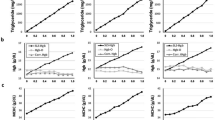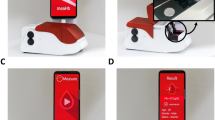Abstract
BACKGROUND: Conventional methods for measuring the total bilirubin concentration in blood require the use of serum or plasma, but physically separating red blood cells from plasma by centrifugation is a time-consuming and potentially dangerous process that does not lend itself to rapid, near-patient testing. Therefore, we have sought to determine whether spectrophotometric measurements of total bilirubin concentration are feasible in unaltered whole blood.
METHODS: We modified an Hb-Quick hemoglobinometer (Avox Systems, Inc., San Antonio, TX), a relatively new, portable, battery-powered instrument that uses disposable cuvettes and a reagentless system to measure total hemoglobin in nonhemolyzed, whole blood. The prototype consisted of an Hb-Quick equipped with light-emitting diodes with emissions at five different wavelengths to measure total bilirubin and total hemoglobin. Using blood samples from neonates with suspected hyperbilirubinemia, we made measurements on plasma from centrifuged samples and on hemolyzed and nonhemolyzed aliquots of the same blood samples.
RESULTS: In the first series of experiments, we compared the Unistat bilirubinometer's readings with the prototype's measurements of bilirubin in plasma. There was a close linear correlation between the prototype's measurements and those of the reference instrument (slope=1.01, r2=0.991). Subsequently, we used the prototype's measurements on plasma as the reference method and compared them with readings on hemolyzed and nonhemolyzed aliquots of each sample. Readings on hemolyzed and nonhemolyzed aliquots were significantly correlated with the measurements in plasma, but the regression lines did not have a slope of 1. However, when the measurements on hemolyzed and nonhemolyzed blood were scaled appropriately to compensate for the fact that red cells “dilute” the bilirubin in plasma, the correlation coefficients improved, and there was then a 1:1 relationship between the measurements in whole blood and plasma.
CONCLUSIONS: These preliminary findings demonstrate the feasibility of developing a portable instrument to measure total bilirubin in unaltered whole blood. The advantages of this method are speed, elimination of centrifugation or other sample preparation, and instrument portability. The disadvantage is that the concentration units are unconventional, i.e., milligrams of bilirubin per volume of whole blood. However, the instrument can be programmed to display the total bilirubin concentration in traditional units, e.g., milligrams of bilirubin per volume of plasma.
This is a preview of subscription content, access via your institution
Access options
Subscribe to this journal
Receive 12 print issues and online access
$259.00 per year
only $21.58 per issue
Buy this article
- Purchase on Springer Link
- Instant access to full article PDF
Prices may be subject to local taxes which are calculated during checkout
Similar content being viewed by others
References
Anonymous Practice parameter: management of hyperbilirubinemia in the healthy term newborn. American Academy of Pediatrics. Provisional Committee for Quality Improvement and Subcommittee on Hyperbilirubinemia Pediatrics 1994 94 (4 Pt 1) 558–65
Catz C, Hanson JW, James W, Simpson L, Yaffe SJ Summary of workshop: early discharge and neonatal hyperbilirubinemia Pediatrics 1995 96 (4) 743–5
Steinke JM, Shepherd AP Comparison of Mie theory and the light scattering of red blood cells Appl Opt 1988 19 4027–33
Gong, AK, Backenstose, B Evaluation of the Hb-Quick®: a portable hemoglobinometer J Clin Monit Comp 1999 15 171–7
Shepherd AP, McMahan CA Role of oximeter error in the diagnosis of shunts Catheter Cardiovasc Diagn 1996 37 435–46
Tayyab S, Ali MK Binding of bilirubin to mammalian erythrocytes Comp Biochem Physiol, Part B: Biochem Mol Biol 1997 118 (5) 97–103
Sato H, Kashiwamata S Interaction of bilirubin with human erythrocyte membranes Biochem J 1983 210 (2) 489–96
Daglio R, Manzoni A, Shepherd AP, Steinke JM, Tonelli D, Volontè S Rapid measurement of total bilirubin in whole blood In: D'Orazio P, Fogh-Andersen N, Larsson L, editors. The Confluence of Critical Care Analysis and Near Patient Testing Madison, WI: Omnipress 1998 p. 416–20
Kjeldsberg C Normal blood and bone marrow values in man In: Lee GR, Bithell TC, Foerster J, Athens JW, Lukens JN, editors. Wintrobe's Clinical Hematology. 9th ed Philadelphia: Lea and Febiger 1993 p. 2298–309
Acknowledgements
The contents of this publication are solely the responsibility of the authors and do not necessarily represent the official views of NHLBI. The authors thank Brianne Backenstose for technical assistance and the nursing staff in the neonatal intensive care unit at University Hospital for help in obtaining the blood samples.
Author information
Authors and Affiliations
Additional information
This project was supported, in part, by grant 1R43 HL-64429 from the National Heart, Lung and Blood Institute.
APPENDIX
APPENDIX
To derive the relationship between the plasma and whole-blood concentrations of bilirubin, we begin with some simple definitions and conventions. Concentration is defined as the amount of bilirubin (Bil) divided by the fluid volume ( V) in which it is dispersed, and we let the subscripts p, rbc, and b denote plasma, red blood cells, and whole blood, respectively.





Equation 2 defines the bilirubin concentration in whole blood, but [Bil] b can be further defined as the sum of the amounts of bilirubin in red blood cells and plasma divided by total blood volume.

However, the amount of bilirubin inside red blood cells is negligible. Thus, Equation 6 becomes

Solving Equation 1 for the amount of bilirubin in plasma and substituting for Bil p in Equation 7 yields

From Equation 3 it can be deduced that the ratio of plasma volume to total blood volume ( Vp/ Vb) is 1−Hct, so substituting 1−Hct into Equation 8 gives

and solving for the bilirubin concentration in plasma, we obtain

Equations 9 and 10 make it readily apparent that the bilirubin concentration in whole blood can be converted into the concentration in plasma (and vice versa), if the hematocrit is known. Similarly, the ratio of total hemoglobin concentration to mean corpuscular hemoglobin concentration (Equation 5) can be used for the same purpose. Substituting [THb]/MCHC for Hct in Equation 10 and rearranging yields Equation 11.

Because the instrument measures both [Bil] b and [THb] in each sample of whole blood, Equations 10 and 11 illustrate how the bilirubin concentration in plasma is easily computed from the measurement in whole blood if either Hct or MCHC is known.
In the present study, we used the prototype's measurement of [THb] and an assumed MCHC of 34 g/dl to convert our measurements in whole blood into the plasma concentration. The error caused by assuming a constant MCHC varies with [THb]. Nevertheless, we can estimate the error introduced by the conversion if the actual MCHC is different from 34. For example, at a [THb] of 15 g/dl and a true [Bil] p of 16 mg/dl, the conversion would overestimate [Bil] p by 1.33 mg/dl (8%) at MCHC=31 and would underestimate [Bil] p by 0.97 mg/dl (6%) at MCHC=37. Fortunately, MCHC varies relatively little in healthy newborns; the standard deviation about the mean is only ±1.65 g/dl. 9 Of course, this SD indicates that 95% have MCHC values within ±3.3 g/dl of the mean.
Rights and permissions
About this article
Cite this article
Steinke, J., Gong, A. & Shepherd, A. Rapid Spectrophotometric Measurements of Total Bilirubin in Intact and Hemolyzed Neonatal Blood: A Feasibility Study. J Perinatol 21, 382–387 (2001). https://doi.org/10.1038/sj.jp.7210547
Published:
Issue Date:
DOI: https://doi.org/10.1038/sj.jp.7210547



